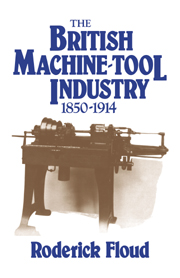Book contents
- Frontmatter
- Contents
- List of tables, figures and appendices
- Preface
- Introduction
- 1 The engineering industries
- 2 The technical history of machine tools, 1850–1914
- 3 The machine tool industry: structure and explanation
- 4 International trade in machine tools
- 5 Greenwood and Batley: history, records and methods
- 6 Greenwood and Batley: markets and prices
- 7 Greenwood and Batley: production
- Conclusion
- List of works cited
- Notes
- Index
3 - The machine tool industry: structure and explanation
Published online by Cambridge University Press: 02 December 2009
- Frontmatter
- Contents
- List of tables, figures and appendices
- Preface
- Introduction
- 1 The engineering industries
- 2 The technical history of machine tools, 1850–1914
- 3 The machine tool industry: structure and explanation
- 4 International trade in machine tools
- 5 Greenwood and Batley: history, records and methods
- 6 Greenwood and Batley: markets and prices
- 7 Greenwood and Batley: production
- Conclusion
- List of works cited
- Notes
- Index
Summary
The fluidity and complexity of the engineering industries as a whole is fully reflected in the machine tool industry, and can be similarly documented from the evidence of the directories. The smaller number of firms in the machine tool industry makes it possible, however, to examine that complexity in more detail than was possible in the first chapter, and to bring to bear additional evidence. In this chapter, therefore, the growth of the machine tool industry will be outlined and examined, on the basis of the aggregative evidence from the directories and similar sources, and on the basis of the scattered information which we possess about the firms in the industry. It is important to emphasise, at the outset, how flawed the evidence is; we have no information on the total output of the industry except at the time of the first Census of Production, and the evidence concerning the operation of individual firms comes primarily from the large and successful firms.
Nevertheless, Kelly's directories make it possible for us to establish, as a first step, the size of the industry in terms of numbers of firms, for the bulk of the period from 1870 to 1914. Table 3.1 presents the results of a number of possible computations of this; the different figures result from different assumptions about the accuracy of the directory material, and from different treatment of firms who appear only once, or who disappear for only a short period.
- Type
- Chapter
- Information
- The British Machine Tool Industry, 1850–1914 , pp. 32 - 67Publisher: Cambridge University PressPrint publication year: 1976
- 2
- Cited by



